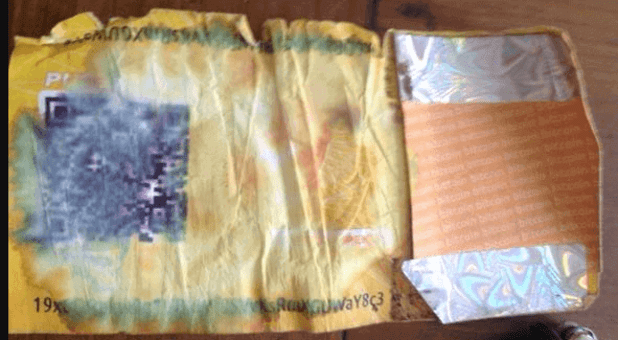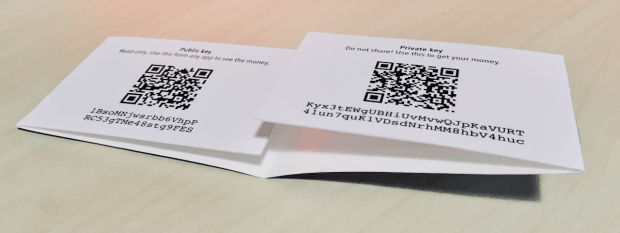A paper wallet is an early method used to protect bitcoin offline. Better methods have replaced it, but people still use paper wallets to store bitcoin safely and inexpensively.
What’s a Paper Wallet?
A paper wallet is a physical document or object that contains a brand new public address and a private key that has been printed out. It allows its users to store the bitcoin sent from another wallet for better safekeeping. Paper wallets are considered non-custodial cold storage because users control the private keys that can and should be printed out offline, thus removing the risks of exposing them to an internet connection’s hacks.
There’s only one way for a malicious actor to get hold of your private key and steal your funds: physically getting control of your piece of paper where the private key is printed.
While paper wallets have decreased in usage over the years because digitally secure devices like hardware wallets have replaced them, they still get some traction among Bitcoiners because of their security and affordability. Today, they are mostly used as Bitcoin ATM receipts.
How do they work
Dedicated generator apps are used to create paper wallets; they print out a public address for receiving bitcoin and a private key that you need to prove ownership and thereby spend your bitcoin. The paper wallet or document might also have a QR code embedded so that it can easily be scanned and signed to make a transaction.
(source: Github)
It is highly recommended that any paper wallet generator apps be used offline to prevent hackers from detecting the private key. Another good practice would be scanning your computer or smartphone with security software to establish whether it has been compromised by malware or any other cyberattack.
Some paper wallet generators will offer the option to save private and public keys on your computer in PDF format. This is strongly advised against because a PDF is constantly exposed to online threats. Similarly, digital pictures or scans of your wallets should be avoided to prevent hackers from detecting them.
Also, ensure that your device’s wireless and Bluetooth are turned off because hackers can exploit those signals to access your device.
You should take further measures to protect any funds stored in paper wallets. Other than working offline when generating a paper wallet, printing the document from a device connected to a printer through a wired and not wireless connection would be a good idea. After printing, ensure you dispose of anything that can digitally store the keys during or after the generation process.
Also, you could generate and use multiple paper wallets, i.e., generate a different wallet for expenses you pay using bitcoins, and use different ones for long-term bitcoin storage.
Advantages and disadvantages
Advantages:
Paper wallets have some advantages, including:
- Maximum protection from cyberattacks, hardware failures, operating system errors and breakdowns, to name a few.
- Useful for long-term storage of funds.
- Can be easily produced as gifts, although Opendime and Satscard are better solutions for gifting nowadays.
- It is easy to generate and print them.
Disadvantages:
They also have the following drawbacks:
- In case of loss, theft or paper degrading, the user will never be able to access the address where their funds are. If you choose this method, ensure you have a safe deposit box or another secure storage method for the paper wallet.
- Destruction can also occur in case of flooding and fire, two major points of failure.
- The private key must be imported to software at some time to move the bitcoin, unlike hardware wallets.
- When withdrawing part of your funds, you risk losing the remaining balance because of the way Bitcoin treats change in transactions.

(source: reddit)
Considerations:
Paper wallets are easy to retrieve, and you can obtain and store your private keys in a matter of minutes if you need quick and straightforward protection for your bitcoin asset.
However, they have been replaced by more practical and secure methods like hardware wallets that still work offline. Like paper wallets, they are very safe but do not suffer from risks like potential paper document destruction.
Storage:
Paper wallet storage should probably be the main concern for its users, as paper is fragile, perishable and easy to lose. Therefore, it should be maintained with extreme care in safe, fireproof and waterproof boxes or third-party custodial deposit boxes.
You also need to protect your paper wallet from being lost or stolen, and it is recommended that you make at least two copies and store them securely — certainly not online. You should also consider laminating your paper wallet. When doing so, ensure it is done safely and that your private keys are not exposed to malicious actors.
Printing:
Before printing out your private keys, you should figure out anything that might go wrong with your machine and anticipate the problem. For instance, paper jams, ink spots or a poorly aligned printer head can all lead to issues when creating your paper wallet.
It’s best to secure the creation of your paper wallet with a well-functioning printer and on a robust piece of paper, as paper deterioration is the main reason people refrain from using this type of storage. Also, do not print on a public or work computer and clear your print queue afterward. You can print something else afterward to ensure the print queue is actually cleared.
Summary
While paper wallets used to be a feasible solution for early bitcoin users who wanted to store their assets safely, at present there are more secure and practical methods like hardware wallets that remove the inefficiencies of paper wallets.
People are still using them to try the method out and temporarily store bitcoin until they find a more suitable solution. More precautions are required when using online tools to transfer or store data online. If you must use a paper wallet, it is recommended that you follow this article’s guidelines to stay safer.








